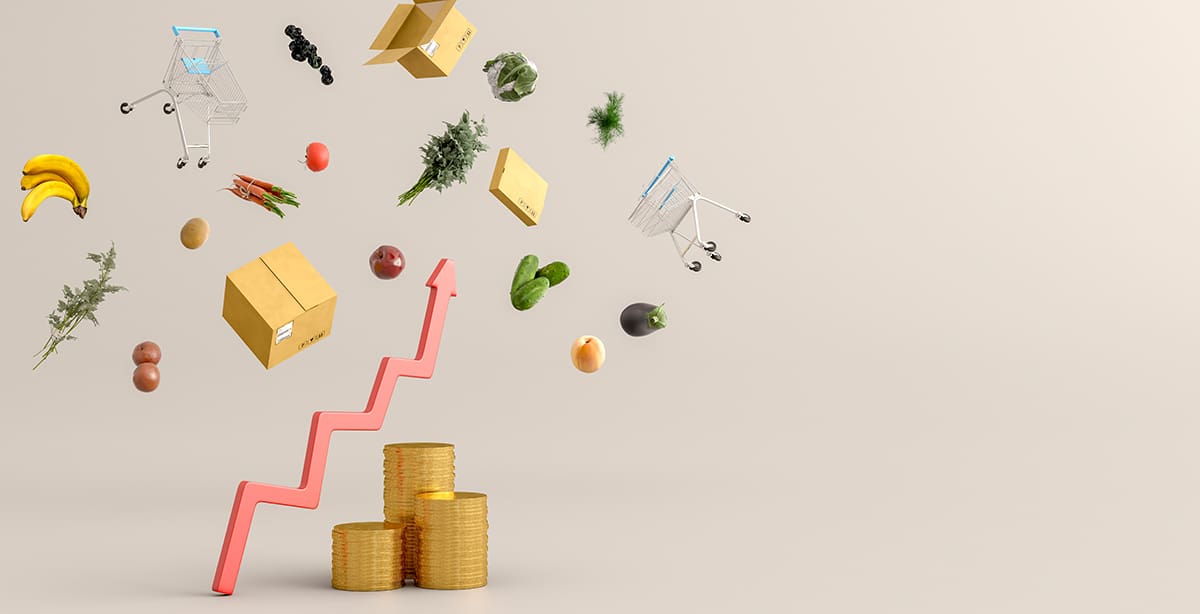Welcome to the 21st Century
So far, the new millennium has been a roller coaster ride for the CPG industry. With success and failure so closely tied to the ups and downs of the economy, the last 20 years have offered a string of boom-and-bust cycles instead of opportunities for steady growth.
Other macro trends, like e-commerce, presented opportunities for new and agile brands, while eroding share from big brands that were late to react. Most recently, the pandemic shook the economy, at first spiking demand for consumer goods and later fueling supply-chain issues.
Now, as the data show consumers have put the pandemic behind them, the CPG industry is facing some of the highest inflation numbers we’ve seen in over 40 years. It seems that it’s time to write a new marketing playbook before the ink has dried on the last one.
What are Consumers Thinking?
Based on some April 2023 data from the Pew Research Center, 35% of Americans rate the current U.S. economy as “poor,” with just 19% of U.S. adults rating it as “excellent” or “good.” This is largely due to the pain they are experiencing from price increases, with 72% of respondents expressing high levels of concern about the costs of food and consumer goods.
What changes are consumers making?
- Cutting spending on non-essential goods such as entertainment, home décor, clothing and appliances (nearly 80%)
- Reducing spending on essential items like groceries, utilities and gas (roughly 66%)
More specifically, U.S. consumers report reducing their spending in the following areas, according to a September 2023 CNBC-Morning Consult survey):
- Clothing and apparel (63%)
- Restaurants and bars (62%)
- Outside-the-home entertainment (56%)
- Groceries (54%)
- Travel and vacations (53%)
- Electronics (50%)
Wow, I Need a Drink …
Or that may be what some of these consumers are thinking … but can they afford their go-to brand? Apparently, this is an area in which consumers have kept the spend flowing despite cutbacks elsewhere … and rising prices. In Q2 of 2023, Molson Coors reported top-line growth of 12%. During this period of inflation, consumers also saw beer prices rise by nearly 6% between April 2022 and April 2023 — and they’re up by over 70% since 2000.
The prices of soft drinks also saw increases in 2023. Consumers’ costs for carbonated soft drinks went up by nearly 15% over the first nine months of the year, with retail up by more than 11% during the same time.
What can marketers take away from all this data?
One thing is for sure: “Non-essential purchases” are subjective. It’s more important than ever for your brand to have a significant, meaningful connection with your consumers. I’ll cut back on movies, subscriptions, and vegetables, but I’m not giving up my favorite beer (Victory Monkeys, by the way).
Is Inflation all bad?
Retailers are known to like a little inflation. Kroger’s CEO has said “somewhere between 3%-4% is optimal.” This is just enough to keep the top-line growing without driving away shoppers.
Over the last year, inflation has hit double digits in some areas — and as seen in the data above, higher prices are pushing many consumers to tighten their belts. That seems significant, but many big retailers — at least in some areas — don’t seem to be feeling the squeeze (yet). Ahold Delhaize recently reported a 3.1% comps increase for Q3 2023, with similar results reported by Publix (4.3% comps increase) and Walmart (4.9% comps increase).
The latest Consumer Price Index numbers were overall flat in October 2023, but the Food Index increased 0.3%, following a 0.2% increase in September. The gasoline index fell 5% in October, hopefully putting some money back in consumers’ wallets. Right now, many eyes are glued to these and other data points that will give clues about how consumers are faring, and what lies ahead for the economy.
What can marketers be doing now?
During the chaotic ups and downs of the last few decades, too many companies were left reacting to external forces with no time to slow down and reset their strategy. And the global pandemic certainly threw wrench after wrench into the machine … forget strategy, marketers were dealing with triage and damage control.
Now is a great time to … catch your breath? … but also a great time to be revisiting your marketing goals and strategies with a long-term and short-term perspective. It is a time to ask the classic strategic questions like:
Where Do We Play?
- Who are our best customers?
- What do we know about them?
- Where can we find them?
- What don’t we know, and how do we find out?
- What do these customers think about us?
- What other customer segments are opportunities?
- Which distribution channels best serve us?
- Which channels present growth opportunities?
- How can we improve relationships with our distributors?
- Where are we “playing” now that we shouldn’t be?
How Do We Win?
- Who is competing where we play?
- Why will consumers pick us over them?
- What can we do that they cannot?
- What are our unique value propositions?
- Do they resonate with our best customers?
- How do we bring new customers to the space?
- How can we tighten the bond with our consumer?
- How do we create value for our partners?
- What new partnerships can help us win?
Questions may vary; these are just to get the wheels turning. There are lots of good ways to approach strategy, and we’re always happy to help. Once you have goals in place, and strategies in place to achieve those goals, you can get back to execution.
Let’s say you operate a premium beer company and the economy starts to tank. Yes, you’ll have some triage to do trying to hold onto retail customers and consumers, but it would be great if you already had some fallback strategies in place. What if you already had a product being tested that was slightly less liquid (8 oz. bottles?) but allowed you to cut prices by 20% while holding margins for you and your retailers? Maybe your loyal customers who were going to have to make a hard choice would gladly accept a slightly smaller portion to be able to continue to enjoy their favorite brand. Or maybe there is a chance to shake up your distribution, or leverage new partnerships. Even working out some of these ideas in theory will keep you prepared for whatever comes next.
As the last few decades have reminded us, it’s hard to predict the future. Long-term plans are great, and necessary — but don’t give up on strategy because you had to take a detour. Or several detours. Keep reworking and revisiting your short-term plan. With every downturn, crash, or unexpected challenge, there is an opportunity to be uncovered … great opportunities for those prepared to search for it and do the work.

